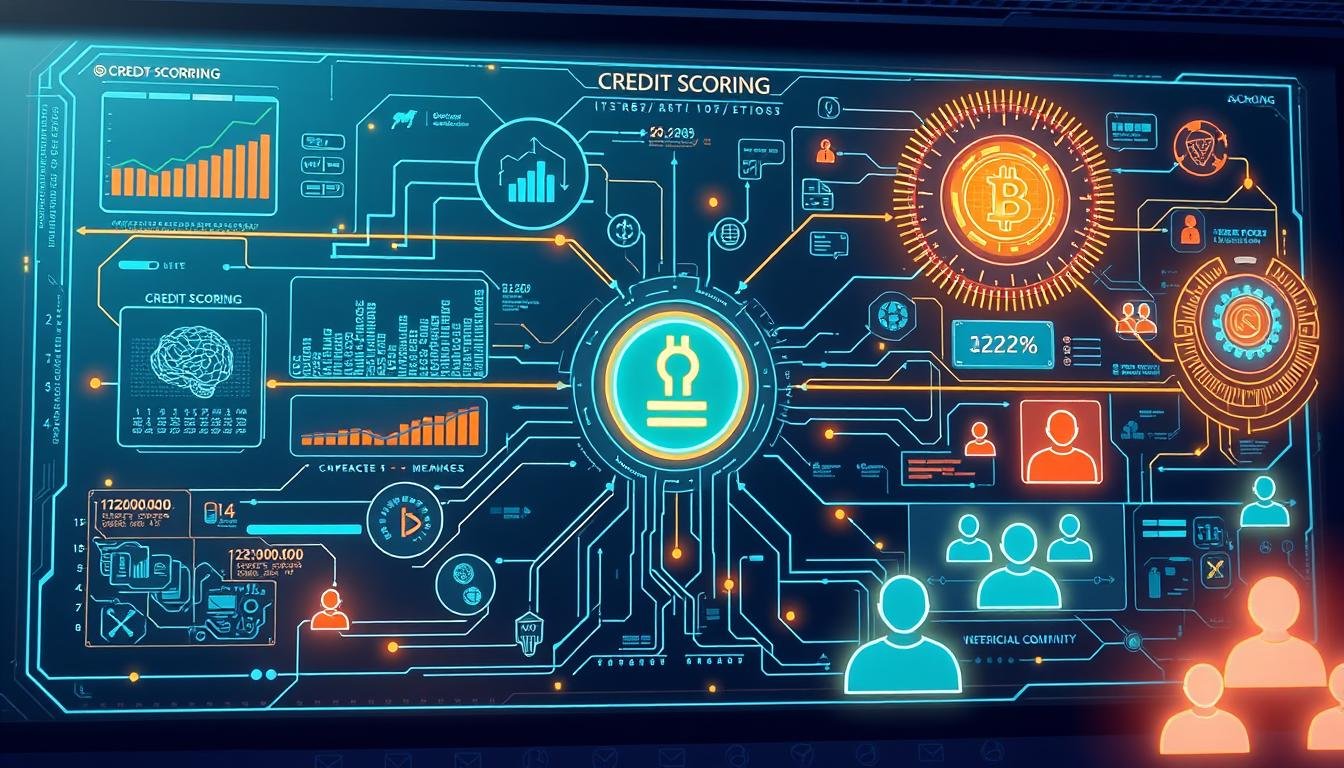The Role of AI in Enhancing Credit Scoring and Risk Assessment
Can artificial intelligence change how we check if someone is trustworthy? The world of finance is always changing. Fintech innovation is making old ways of checking credit seem outdated. By using AI, banks can predict better and help more people get financial help.
With almost seven billion people using smartphones, telcos are key in giving out important data. Old ways of checking credit can’t handle all this data. But AI can, by using all kinds of data from telcos. This leads to better, more fair financial services for everyone.
AI keeps getting better with new data, making risk checks more accurate in real time. This makes financial services more open and trustworthy. It helps people who can’t get loans because they don’t have a good credit history. This way, more people can get the financial help they need.
Key Takeaways
- AI credit scoring uses many data sources, making risk checks more accurate.
- Using telco data helps fintech innovation make better predictions.
- AI models show what data matters most in credit checks, making things clearer.
- AI’s ability to update quickly helps make better, faster decisions.
- This tech helps more people get financial help, including the unbanked and those with little credit history.
The Evolution of Credit Scoring: Traditional vs. AI-Based Models
Traditional credit scoring uses old data to give scores from 300 to 850. These methods look at just a few financial signs. This can leave out people with little credit history. AI-based models change this by using more data, like social media and job status, to judge creditworthiness better.
Modern credit scoring uses machine learning to find patterns in big data. Unlike old methods, AI can use real-time data for fast, accurate decisions. It looks at things like current income and online buying habits.
AI scoring helps everyone get credit, not just those with a lot of history. It uses new data like utility bills to score fairly. This makes scoring more open to all.
AI scoring also helps manage risks better. It helps lenders avoid bad loans and make better choices. AI tools make it easier to see and understand these risks.
But, AI scoring faces rules and fairness issues. It’s important to follow data laws and avoid unfair biases. This ensures AI is used right in judging credit.
In the end, AI has made credit scoring better. It’s more fair, accurate, and efficient. AI and machine learning have changed the game for credit risk and lending.
How AI and Machine Learning Transform Credit Risk Assessment
AI and machine learning have changed how we assess credit risk. They give banks tools to predict better. By using data like how people behave online, AI makes credit profiles more detailed.
This new way of looking at credit lets banks understand borrowers better. It also helps spot potential risks more clearly.
The market for AI in banking is growing fast. It’s expected to jump from $12 billion in 2023 to over $36 billion by 2028. This shows how much banks rely on AI for managing risks.
In Ireland, 45% of banks used AI for risk management by 2022. Another 30% plan to use it by 2025.
Data collection and analysis are key for AI and machine learning. Predictive analytics help banks guess how people will behave financially. This makes risk assessments more accurate.
These models can learn from new data quickly. This keeps them up-to-date and accurate as the market changes.
Gen AI brings new features like using different kinds of data. It can find credit opportunities for people who are often overlooked. It also helps spot fraud by looking for unusual patterns in data.
AI uses new techniques like SMOTEENN to improve how models are trained. This makes sure the models are reliable and accurate.
Medium-sized banks in Ireland might spend €2 million to €5 million on AI for credit risk. But, they can see a good return on this investment in 2 to 3 years.
AI also helps banks follow rules like fair lending. It makes sure credit checks are fair and transparent. AI helps find the right people to lend to, reducing the risk of defaults.
The Role of AI in Enhancing Credit Scoring and Risk Assessment
AI is changing how we score credit and assess risks. It’s making credit scoring more inclusive for those without bank accounts. Traditional methods use only a few data points. But AI looks at more, like social media and utility bills.
Financial companies and fintech use AI to make better lending choices. They use automated systems to speed up loan approvals. For example, Mosaic cut its approval time from nine to four days with AI.
AI offers many benefits, like faster and more accurate decisions. It helps spot fraud and improves customer service. It also lets businesses keep an eye on credit risks in real-time.
AI’s algorithms get better with time, thanks to new data. This is key in changing markets. It makes credit scoring fairer and more reliable for everyone, not just the well-off.
AI also helps reduce bias in credit checks. It looks at a wide range of data. This helps include more people and businesses in the financial world.
Overcoming Challenges: Transparency and Bias Mitigation in AI Credit Scoring
AI is changing credit scoring, but it also brings big challenges. The “Black Box” Problem and biases in decision-making are major issues. It’s crucial to tackle these to ensure fairness and transparency in AI credit assessments.
To solve the “Black Box” Problem, Explainable AI (XAI) models are being created. These models aim to make AI’s decision-making clear. By explaining AI’s decisions, XAI builds trust among users, regulators, and financial institutions. This trust is key because loan applicants need to know why their applications are approved or rejected.
Techniques for bias mitigation are also being used to make AI credit scoring fairer. Without careful management, AI can keep financial inequalities alive. Efforts to mitigate bias aim to prevent discrimination based on race, gender, or other protected characteristics.
- Data Preparation and Cleaning: Essential for accurate and unbiased outcomes. This addresses issues like unrepresentative data samples and demographic biases.
- Transparent Models: Developing models that clearly explain their decision-making processes to ensure every stakeholder understands the rationale behind approvals or rejections.
- Regular Monitoring: Continuous scrutiny and testing of AI models to identify and rectify biases promptly.
The move towards transparent and unbiased AI models is significant. Traditional credit scoring has evolved into AI-enhanced risk assessment systems. Early models used structured data like FICO scores, focusing on past financial behavior. Now, AI models use diverse data, such as social media and real-time payments, for a more dynamic and accurate assessment.
AI systems can quickly adapt to new data, offering precise risk assessments. This helps financial institutions make informed decisions quickly. It reduces non-performing loans and promotes financial inclusion.
| Traditional Credit Scoring | AI-Based Credit Scoring |
|---|---|
| Relies on structured data like credit history | Uses diverse data sources including social media |
| Static models | Adaptive models learning from new data |
| Less accurate in capturing borrower complexities | More accurate by identifying nuanced borrower behavior |
Overcoming the “Black Box” Problem and biases in AI credit scoring is key. It will lead to fairer, more transparent, and efficient lending practices. Financial institutions must focus on developing and using XAI models and strong bias mitigation techniques to achieve these goals.
AI-Powered Credit Risk Management for Large Enterprises
Large companies are now using AI for better credit risk management. AI can quickly and accurately analyze huge amounts of data. This means faster and more accurate risk checks and better fraud detection. For instance, Cedar Rose has been using AI since 2004. They turned raw data into useful information, becoming the first Middle Eastern company to use AI for credit scores in 2018.
AI solutions offer more than old methods by using different data types. American Express used AI to cut default rates by 10% and increase approvals by 15%. Upstart and ZestFinance also use new data for better credit scores. This helps more people get credit and lowers defaults.
AI also makes customer experiences better. It tailors credit products to fit each customer’s needs. This boosts satisfaction and loyalty. Paytm and Razorpay use AI to offer loans that fit each user’s profile. This approach reduces risks and offers more credit options.
The use of AI in finance is growing fast. The market for credit scoring services is expected to hit USD 18.97 billion in 2022. It’s also expected to grow by 24.06% from 2023 to 2030. Fraud detection in finance is also expected to grow by 36.8% from 2023 to 2032. This shows a big push towards using AI for managing credit risks.
| Company | Implementation | Outcome |
|---|---|---|
| American Express | Machine Learning Algorithms | 10% reduction in default rates, 15% increase in credit approvals |
| Upstart | Non-Traditional Data Points | Significant reduction in default rates |
| ZestFinance | Alternative Credit Scoring | Promoted financial inclusion |
| Paytm | AI for User Behavior Analysis | Enhanced customer-specific loan products |
| Razorpay | Transaction Data Analysis | Tailored lending solutions |
As AI gets better, big companies need to think about ethics too. They must consider data privacy, fairness, and transparency. But AI’s ability to quickly and accurately assess risks makes it a key tool for managing credit risks in the future.
Conclusion
AI has changed the game in credit scoring and risk assessment. It brings many benefits to the financial world. AI uses lots of data, from financial records to social media, to make better predictions.
McKinsey says AI could add $1 trillion to the banking industry each year. This shows how big of an impact AI has on finance.
AI makes decisions faster and more accurately. For example, a 2022 platform cut decision time by 50% and boosted loan approvals by 20%. This shows AI’s power to improve customer service and save costs.
The future of credit scoring will focus on being fair and accurate. It aims to help more people get credit. The AI banking market is expected to grow a lot, reaching $160 billion by 2024 and $300 billion by 2030.
Financial institutions need to use AI wisely. AI will keep getting better, helping the financial sector become more fair and efficient.
Source Links
- How can AI enhance risk assessment in credit risk scoring?
- AI Credit Scoring: The Future of Credit Risk Assessment
- Artificial Intelligence in Credit Risk Management
- AI Credit Scoring: The Future of Credit Risk Assessment – LatentView Analytics
- Rise of AI-Enhanced Credit Scoring Systems
- The Role of AI and Machine Learning in Revolutionizing Credit Risk Management in the Irish Banking Sector: A Research-Based Analysis
- How Generative AI Is Transforming Credit Risk Assessment
- Revolutionize AI & ML in Credit Scoring: Enhancing Accuracy
- How AI is Transforming Credit Risk Management?
- Credit Scoring and Risk Assessment with AI
- AI-Driven Risk Assessment Models: Revolutionizing Credit Scoring and Default Prediction
- Overcoming Human Bias with AI Credit Scoring Models
- AI-Powered Credit Models Are a Strategic Imperative for Banks
- AI-Powered Credit Scoring & Financial Risk Management | Atrina
- How AI and Machine Learning Revolutionise Credit Risk Assessments
- Transforming Credit Risk Management: The Impact Of AI And ML – Avenga
- The Role Of AI In Transforming Credit Risk Assessment Process
- AI Credit Scoring: The Role of AI in Modern Credit Risk Assessment








